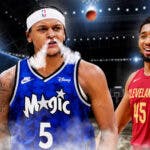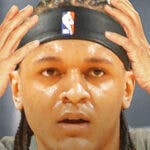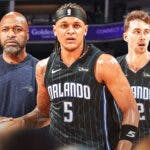This is a big year for Aaron Gordon. Orlando's 22 year old forward is set to enter restricted free agency this summer after the two sides failed to reach an agreement on an extension. Gordon has placed a bet that his play this year will dictate his value in free agency. 40 games into the season, that bet looks like it will pay off for him in a big way. Now that he's been shifted to his natural position at power forward, Gordon has looked like a budding star for the Magic, averaging 19.2 points, 8.1 rebounds and 2.0 assists per game while shooting 47.1% from the field and 37% from deep. His vastly improved play on the court has him in the conversation for most improved player. Here's a look at the new and improved Aaron Gordon.

Same Beast, Different Animal
Let's start with the obvious. Aaron Gordon is still the same athletic beast he's always been, he's a high-flying, explosive finisher who's a threat to destroy the rim every night. Here's what he's done in recent games.
Gordon is 17th in the league with 43 dunks. He has the ability to attack the basket in a variety of ways: off the dribble, as a cutter or off the pick and roll. The Arizona import has always been a great finisher, using his strength and explosiveness to fight through contact. Through their first four seasons, Gordon is on par with Lebron, both finishing around the rim at a steady 68.5%.
AG is a tweener in the best sense of the word. As a 6'9 220 lb power forward, his athleticism is a key advantage that allows him to beat bigger and slower defenders to the rim. Teams that try to counter his speed by putting small forwards on him quickly pay the price as he excels at using his size and physicality to beat smaller defenders. Gordon is at his best when the Magic play up-tempo aggressive basketball. His offensive versatility and athleticism from the four spot make him a perfect fit in modern NBA offenses.

This season, Aaron Gordon has made huge strides in expanding his offensive game. The table below illustrates his growing offensive repertoire and his impressive performance ranked among the NBA. With his improvement this season, AG looks primed to take the league by storm as one of its bright young stars.

Consistency from Deep
Let's start with the most impressive development, shooting. The biggest concern echoed by every scout in the 2014 NBA draft was that Aaron Gordon has no jumper. In his only season in college, Gordon averaged 42% from the free throw line and struggled to shoot from outside the paint. This concern carried itself into the beginning of his NBA career where Gordon averaged 28.5% from 3 and a sterling 23% from 10+ feet in his rookie year. While he's made some small shooting improvements since then, Gordon came into the season still averaging 28.5% from beyond the arc, a less than impressive number for a league continually predicated on long-range shooting. Halfway through the 18-19 season, Gordon has blown his career percentages out of the water.
Aaron Gordon has looked like a completely different shooter this season. He's shooting a career best 39% from 3 and he's evolved into a dependable catch-and-shoot weapon for the Magic. Gordon attempts 21.2% of his shots off spot-up opportunities and improved to 1.04 points per possession.. (Note that NBA.com defines spot-up opportunities as both catch-and-shoot and catch-and-drive plays.) From pure catch-and-shoot possessions, Gordon is shooting 45.0% from 3 and 37.5% from 2 but what's really impressive beyond those numbers is that Aaron Gordon is looking like an elite off-ball shooter statistically, averaging 1.31 points per possession and ranking in the 90th percentile for off-screen shooting. To juxtapose, last year he averaged 0.75 points per possession and ranked a hard to respect 24th percentile in the league in off-screen possessions.

Watch how comfortable Gordon looks coming off screens in the video above. He's shooting with more confidence than ever before and the coaches no longer cringe when he shoots off of any kind of motion. In fact, Vogel drew up an end of game play to get Gordon open for a three against Miami. He didn't make the shot but that sentence alone would've sounded crazy last year if you said it to any Magic fan. This year, Gordon is shooting 40% of his shots come from beyond the arc and has become a reliable shooter from deep. His next challenge will be sustaining his success once teams start to change their defensive game plans to account for his shooting. Despite his improvement, Gordon still has trouble converting from three when defenders play tight defense on him.
In the Post
Another area of improvement has been Gordon's post game. Gordon hadn't shown much of a post game thus far in the league, another concern that scouts expressed back in 2014. Last year, AG averaged 0.79 ppp on post-ups and only ranked in the 25th percentile. He's shown improvement this year, bumping his numbers up to 0.98 ppp and 73rd percentile. More importantly, he's started to show more diversity and finesse in the post. Gordon's post game previously consisted of aggressive backdowns and…aggressive backdowns but his improved footwork this year has helped him better leverage his strength and size to score more effectively over smaller defenders. Likewise, his tighter handle has allowed him to assert more control over his post-ups and gives him more versatility in the way he attacks defenders. One move that AG has really developed this year is his post fadeaway. Check it out in the play below, that spin move into the turnaround fadeaway is a thing of beauty.
From Good to Great
Aaron Gordon has always been a great off-ball player. Gordon was essentially drafted for his athleticism and his ability to score off hustle type plays: rolling off P&Rs, cutting to the basket, in transition and off putbacks. Looking back at last year, Gordon was more than respectable ranking 80th percentile as a P&R finisher, 99th percentile as a cutter and 74th percentile at putbacks. This year, he's verged into elite territory where he ranks 94th, 96th and 92nd percentile in those same play types respectively.
Gordon is one of those guys that players love to pass to. His athleticism and finishing ability is well complemented by his ability to cut and fill the lane correctly both in transition and in the half-court. Throw the ball anywhere in his vicinity and he'll rise up and finish it over anyone. Most defenders don't want anything to do with contesting his finishes. As a roll man and as a cutter, Aaron is fast enough to beat opposing bigs and rotating help to the rim and big enough to finish over smaller defenders. Further highlighting Gordon's finishing ability, he's currently 8th in field goal percentage for shots within 5 feet of the basket (>1 field goal made a game) at 74.6%.
Success on the offensive glass usually comes down to good positioning and effort. Watch this play from last night. Gordon secures the rebound and scores on the putback over the entire Mavericks team. Simply relentless. Gordon is in the 92nd percentile for putback plays this year, averaging 1.4 offensive rebounds per game and 1.46 points per putback possession. His performance on the offensive glass is impressive not just because of his ability to grab rebounds but also for his ability to convert efficiently on the putback as well.
Pick and Roll
Gordon would be downright scary if he was playing with better passers within a better offense. Elfrid Payton ranks in the 57th percentile among P&R ball-handlers this year. Payton's improvement as a shooter has helped create more flexibility in the pick & roll, but his decision-making isn't elite which is a limiting factor to his ability to consistently execute in those possessions. Most teams still leave Payton wide open, compromising spacing and daring him to shoot. However in his defense, Orlando is maybe the worst screen-setting team in the league and that comes down to collective team effort, coaching and lazy bigs. Gordon is one of the better screeners on the the team but he's not blameless and can definitely work on setting harder screens as well. Without strong screens, Payton is often left without much to work with. Still, Payton and Gordon have played together for four years and occasionally show great chemistry together especially in the open court or off short interior lob passes from Payton.
Gordon himself is a developing P&R ball handler, he sees a few possessions per game where he conducts the pick & roll and averages 0.82 ppp. He can consistently make the simple read in P&Rs and has shown the ability to hit the open man off the roll or in the corner but his court vision is a work in progress and he has a ways to go before he'll be able to execute the more nuanced complexities of pick and rolls. This year, he's also shown a tighter handle which has helped his game tremendously. Gordon has mostly been a straight line driver in his career but his improved handle is giving him more options to choose from when attacking the paint. As it continues to develop, his handle should also make him more comfortable in pick & roll and ball-handling situations. Orlando's coaches are starting to give Gordon more looks as the ball-handler as they toy with the idea of running parts of the offense through him. Aaron has responded positively as he shows flashes of capable playmaking. As he continues to work on his passing and vision, Gordon should be able to take on more playmaking responsibilities for the team.

Regarding Defense
Defensively, Gordon is a work in progress. While he's prone to mental lapses and missed reads and rotations like most young players, Gordon has shown a willingness to play defense and displays high effort. As a smaller power forward, he also struggles at times containing bigger players in the post and securing position. Gordon has the physical tools to be a plus defender. With his high work ethic and willingness to listen to the coaching staff, it seems likely that he'll be able to translate his potential into a positive defensive performance in the future. However, it's hard to statistically evaluate Gordon's individual defense or that of his teammates given the entire team's struggles on the defensive end.

Orlando's generalized struggles on defense can be traced back to a lack of urgency on that end of the floor and a limited number of defensive players on the court. Players like Vucevic and Fournier are low effort defenders and the team in general has struggled to bring consistent energy on a nightly basis. With the right personnel changes and injury recoveries, the Magic has a chance to right the ship defensively. Bismack Biyombo profiles to be a rim protector that can help anchor their defense. His blocks and athletic play should help to energize the rest of the team and trigger precious fast break opportunities. Pairing Gordon with players like Biyombo and Jonathan Isaac should ensure that the team can show more consistent effort and dedication on defense.

Star in the Making
Halfway through the season, Aaron Gordon has emerged as a star in the making and one of the few bright spots in an otherwise disappointing season for Orlando. At just 22, he has demonstrated maturity and a work ethic beyond his years. Coming into the league as an athletic freak with a limited skill-set, Gordon has developed a versatile offensive repertoire that enables him to score effectively in a number of ways. His numbers have improved from 12.7/5.1/1.9 on 45.4% from the floor and 28.8% from three last year to 19.2/8.1/2.0 on 48.4% and 39% this year. But Gordon's candidacy for Most Improved Player is about more than just statistical growth. Aaron has developed critical areas of his game this year. The most impressive among these improvements is definitely his refined shooting ability. However, Gordon's tighter handle, emerging post game, improved playmaking and elite finishing have made him a well-rounded player and collectively position him as one of the best young players in the league.

One area that Gordon can improve on is his decision making. Aaron can play like a superstar even though his talent isn't quite there yet. He's prone to taking tough shots, pulling up off the dribble on shots that make fans and coaches alike cringe. Other times he can force passes that he can't convert or simply aren't there. His shot selection has improved this year and he's more conservative with his playmaking unless he gets frustrated. On the other hand, his talent is rising to the level where the cringe-worthy plays he was making before suddenly look much more plausible. Gordon still has a lot to learn before he can be seen as a star-level player but these types of plays highlight his confidence in himself and serve as markers indicating his proximity to the realm of becoming a game-changing talent.

Orlando would do well to re-orient their offense around Gordon as their first option, especially with Nikola Vucevic's injury sidelining him for a few more weeks. The combination of his physical tools and emergent skill-set have primed him to be a rim-rattling playmaker who spreads the floor effectively from the power forward position, making him an excellent fit as a prototypical power forward in today's fast-paced offenses. Gordon's abundant athleticism is paced by his rapidly developing offensive game as he creeps closer and closer towards the cusp of stardom. His impressive growth as a player has thrust him into contention for most improved player this season and has him in the discussion as one of the brightest young players in the league.




